(p. 5A) PORT-AU-PRINCE, Haiti (AP) — Scientists have presented the strongest evidence yet that U.N. peacekeepers imported the cholera strain that has killed more than 5,500 people in Haiti.
A report published in the July issue of the Emerging Infectious Diseases journal says research findings “strongly suggest” that the U.N. contingent from Nepal contaminated a Haitian river because of poor sanitation at a base. Author Renaud Piarroux had previously blamed peacekeepers. This study is more complete and its methodology was reviewed by other scientists.
Month: July 2011
Capitalism Was Not Inevitable
Source of book image:
http://ecx.images-amazon.com/images/I/519PfT2oUtL.jpg
(p. 15) What is the nature of capitalism? For Joseph Schumpeter, the Austrian-born economist whose writings have acquired a special relevance in the past year or two, this most modern of economic systems “incessantly revolutionizes the economic structure from within, incessantly destroying the old one, incessantly creating a new one.” Capitalism, Schumpeter proclaimed, cannot stand still; it is a system driven by waves of entrepreneurial innovation, or what he memorably described as a “perennial gale of creative destruction.”
Schumpeter died in 1950, but his ghost looms large over Joyce Appleby’s splendid new account of the “relentless revolution” unleashed by capitalism from the 16th century onward. Appleby, a distinguished historian who has dedicated her career to studying the origins of capitalism in the Anglo-American world, here broadens her scope to take in the global history of capitalism in all its creative — and destructive — glory.
She begins “The Relentless Revolution” by noting that the rise of the economic system we call capitalism was in many ways improbable. It was, she rightly observes, “a startling departure from the norms that had prevailed for 4,000 years,” signaling the arrival of a new mentality, one that permitted private investors to pursue profits at the expense of older values and customs.
In viewing capitalism as an extension of a culture unique to a particular time and place, Appleby is understandably contemptuous of those who posit, in the spirit of Adam Smith, that capitalism was a natural outgrowth of human nature. She is equally scornful of those who believe that its emergence was in any way inevitable or inexorable.
. . .
. . . , she captures how a new generation of now forgotten economic writers active long before Adam Smith built a case “that the elements in any economy were negotiable and fluid, the exact opposite of the stasis so long desired.” This was a revolution of the mind, not machines, and it ushered in profound changes in how people viewed everything from usury to joint stock companies. As she bluntly concludes, “there can be no capitalism . . . without a culture of capitalism.”
. . .
The individual entrepreneur is at the center of her analysis, and her book offers thumbnail sketches of British innovators from James Watt to Josiah Wedgwood. She continues on to the United States and Germany, giving readers a whirlwind tour of the lives and achievements of a host of men whom she calls “industrial leviathans” — Vanderbilt, Rockefeller and Carnegie in the United States; Thyssen, Siemens and Zeiss in Germany. All created new industries while destroying old ones.
For the full review, see:
STEPHEN MIHM. “Capitalist Chameleon.” The New York Times Book Review (Sun., January 24, 2010): 15.
(Note: ellipses added except for the one in the “there can be no capitalism . . . without a culture of capitalism” quote.)
(Note: the online version of the review is dated January 22, 2010.)
Book under review:
Appleby, Joyce. The Relentless Revolution: A History of Capitalism. New York: W. W. Norton & Company, 2010.
Resistance to New Technology
(p. 59) . . . , not everyone was happy with the loss of open hearths. Many people missed the drifting smoke and were convinced they had been healthier when kept “well kippered in wood smoke,” as one observer put it. As late as 1577, a William Harrison insisted that in the days of open fires our heads did never ake.” Smoke in the roof space discouraged nesting birds and was believed to strengthen timbers. Above all, people complained that they weren’t nearly as warm as before, which was true. Because fireplaces were so inefficient, they were constantly enlarged. Some became so enormous that they were built with benches in them, letting people sit inside the fireplace, almost the only place in the house where they could be really warm.
Source:
Bryson, Bill. At Home: A Short History of Private Life. New York: Doubleday, 2010.
(Note: ellipsis added.)
Zuckerberg Has Most Followers on Google+
“The profile page of Mark Zuckerberg on Google+, a service created to compete with Facebook.” Source of caption and image: online version of the NYT article quoted and cited below.
(p. B1) Any guesses as to who is the most popular person on Google+, the company’s new social networking service? Ashton Kutcher, perhaps? Or Lady Gaga?
Actually, that title is currently held by Mark Zuckerberg, the founder and chief executive of Facebook — the very service that Google+ was meant to challenge.
As of Tuesday evening, Mr. Zuckerberg had nearly 35,000 people following his updates on the service, more than anyone else in a broad survey of Google+ profiles by Social Statistics, an outside service. His fan base exceeds that of Larry Page, one of the founders of Google and its recently appointed chief executive, who had only 24,000 people following him.
Google+ is less than a week old and is still not yet widely available to the public. But access to the service, which lets people share photos, links, status updates and video chats with groups of friends, is already in high demand among early adopters who are eager to play with its (p. B8) features. That includes Mr. Zuckerberg, who apparently signed up to keep tabs on his new adversary.
For the full story, see:
JENNA WORTHAM. “Zuckerberg Finds Fans on Google+.” The New York Times (Weds., July 5, 2011): B1 & B8.
(Note: the online version of the story is dated July 6, 2011.)
Cow Burps and Farts Cause 28% of Methane Release “Due to Human Activity”
(p. 6A) LOS ANGELES — Scientists have isolated a bacterium from the gut of Australian Tammar wallabies that allows the animals to consume and digest grasses, leaves and other plant material without producing copious amounts of methane, as cattle do.
The microbe was discovered through a process described in a report published online recently by the journal Science.
Ultimately, the microbe might be put to use to reduce the carbon footprint of cows and other ruminants, said report co-author Mark Morrison, a microbial biologist in St. Lucia, Queensland.
. . .
The methane-rich burps and flatulence of cattle have been blamed for 28 percent of that greenhouse gas’s global emissions due to human activity. Like other cud-chewing mammals, they produce methane as their systems work to break down and ferment the plant matter they eat.
For the full story, see:
THE LOS ANGELES TIMES. “Wallaby microbe may one day help cut cows’ methane footprint.” Omaha World-Herald (Monday, July 4, 2011): 6A.
(Note: ellipsis added.)
Technology as an Enabler of Free Speech
 “Volunteers have built a wireless Internet around Jalalabad, Afghanistan, from off-the-shelf electronics and ordinary materials.” Source of caption and photo: online version of the NYT article quoted and cited below.
“Volunteers have built a wireless Internet around Jalalabad, Afghanistan, from off-the-shelf electronics and ordinary materials.” Source of caption and photo: online version of the NYT article quoted and cited below.
The main point of the passages quoted below is to illustrate how, with the right technology, we can dance around tyrants in order to enable human freedom.
(But as a minor aside, note in the large, top-of-front-page photo above, that Apple once again is visibly the instrument of human betterment—somewhere, before turning to his next challenge, one imagines a fleeting smile on the face of entrepreneur Steve Jobs.)
(p. 1) The Obama administration is leading a global effort to deploy “shadow” Internet and mobile phone systems that dissidents can use to undermine repressive governments that seek to silence them by censoring or shutting down telecommunications networks.
The effort includes secretive projects to create independent cellphone networks inside foreign countries, as well as one operation out of a spy novel in a fifth-floor shop on L Street in Washington, where a group of young entrepreneurs who look as if they could be in a garage band are fitting deceptively innocent-looking hardware into a prototype “Internet in a suitcase.”
Financed with a $2 million State Department grant, the suitcase could be secreted across a border and quickly set up to allow wireless communication over a wide area with a link to the global Internet.
For the full story, see:
JAMES GLANZ and JOHN MARKOFF. “U.S. Underwrites Internet Detour Around Censors.” The New York Times, First Section (Sun., June 12, 2011): 1 & 8.
Source of graphic: online version of the NYT article quoted and cited above.
Medieval Pollution
(p. 58) One thing that did not escape notice in medieval times was that nearly all the space above head height was unusable because it was so generally filled with smoke. An open hearth had certain clear advantages–it radiated heat in all directions and allowed people to sit around it on all four sides–but it was also like having a permanent bonfire in the middle of one’s living room. Smoke went wherever passing drafts directed it–and with many people coming and going, and all the windows glassless, every passing gust must have brought somebody a faceful of smoke–or otherwise rose up to the ceiling and hung thickly until it leaked out a hole in the roof.
Source:
Bryson, Bill. At Home: A Short History of Private Life. New York: Doubleday, 2010.
Bricks-and-Mortar Restaurants Use Police (Instead of Better Food) to Beat Food Trucks
 “Kim Ima and Kenny Lao parked their food trucks on Front Street in Dumbo.” Source of caption and photo: online version of the NYT article quoted and cited below.
“Kim Ima and Kenny Lao parked their food trucks on Front Street in Dumbo.” Source of caption and photo: online version of the NYT article quoted and cited below.
(p. D4) FOOD trucks, those rolling symbols of New York City’s infatuation with haute casual food, are suddenly being chased from Midtown Manhattan. In the last 10 days, the Treats Truck, which has sold cookies and brownies for four years during lunchtime at West 45th Street near Avenue of the Americas, has been told by police officers that it is no longer welcome there, nor at its late-afternoon 38th Street and Fifth Avenue location. The Rickshaw Dumpling truck, a presence for three years at West 45th Street near the Treats Truck, has been shooed away as well.
The police “have told us they no longer want food trucks in Midtown,” said Kim Ima, the owner of the Treats Truck, a pioneer of the city’s new-wave food-truck movement, who began cultivating customers on West 45th Street in 2007.
. . .
Mr. Lao and other food-truck operators said they suspect that the police are responding to complaints by brick-and-mortar businesses that resent competition. Such was the case last year, when store merchants on the Upper East Side complained about Patty’s Taco Truck, which sold tortas, tacos de lengua and cemitas on Lexington Avenue. The truck was towed several times and the operator arrested, prompting the Street Vendor Project, an advocate for vendors based at the Urban Justice Center, to file the lawsuit that resulted in Judge Wright’s ruling, which said food is merchandise that can be regulated.
For the full story, see:
GLENN COLLINS. “Food Trucks Shooed From Midtown.” The New York Times (Weds., June 29, 2011): D4.
(Note: ellipsis added.)
(Note: the online version of the story is dated June 28, 2011.)
$130,000 Federal Stimulus Used by Omaha Public Schools for Manual Attacking American Institutions
(p. 1A) The Omaha Public Schools used more than $130,000 in federal stimulus dollars to buy each teacher, administrator and staff member a manual on how to become more culturally sensitive.
The book by Virginia education consultants could raise some eyebrows with its viewpoints.
The authors assert that American government and institutions create advantages that “channel wealth and power to white people,” that color-blindness will not end racism and that educators should “take action for social justice.”
The book says that teachers should acknowledge historical systemic oppression in schools, including racism, sexism, homophobia and “ableism,” defined by the authors as discrimination or prejudice against people with disabilities.
The authors argue that public school teachers must raise their cultural awareness to better serve minority students and improve academic achievement.
For the full story, see:
Joe Dejka. “OPS Says It Won’t Go totally by the Book.” Omaha World-Herald (Sunday, July 10, 2011): 1A & 2A.
(Note: the online version of the article has the title “OPS buys 8,000 diversity manuals.”)
Entrepreneurs Stanley and Wood Apply Econometrics to Business Data Analysis
 “Grant Stanley, left, and Tadd Wood founded Contemporary Analysis, which uses data to solve sales, marketing, customer retention, employee management and planning problems.” Source of caption and photo: online version of the Omaha World-Herald article quoted and cited below.
“Grant Stanley, left, and Tadd Wood founded Contemporary Analysis, which uses data to solve sales, marketing, customer retention, employee management and planning problems.” Source of caption and photo: online version of the Omaha World-Herald article quoted and cited below.
The entrepreneurs celebrated in the article quoted below are former students of mine. Grant Stanley was in my Economics of Entrepreneurship and Economics of Technology seminars and Tadd Wood was in my Honors Colloquium on Creative Destruction. I wish them well.
(p. 1D) A half-dozen 20-something math, economics and neuroscience whizzes form Contemporary Analysis, an Omaha-based firm that is making predictive analytics available to a wider array of firms faster and for less money.
The team, which has a penchant for roaming around its Old Market office shoeless, is led by Grant Stanley, 23, the company’s chief executive. He founded the firm in March 2008 with Tadd Wood, 23, who is now a senior analyst.
For nearly three years, Contemporary Analysis has built a customer base mostly of companies and businesses with lean budgets, meaning they didn’t have a lot of cash to spend on analytics products. Traditionally, analytics firms lock clients into expensive, long-term contracts.
Not Contemporary Analysis.
Their products are designed to yield results in about a month, and average contracts are about $5,000, Stanley said. The company’s analytics tools use data to solve sales, marketing, customer retention, employee management and planning problems.
. . .
(p. 2D) A . . . report from the IBM Institute for Business Value found that top-performing organizations use analytics five times more than lower performers.
Of the 3,000 executives, managers and analysts polled for the IBM report, those who came from high-performing companies said they used analytics to guide future strategies 45 percent of the time and day-to-day operations 53 percent of the time. By comparison, lower-performing firms used analytics 20 percent when addressing future business matters and 27 percent on a daily basis.
For the full story, see:
Ross Boettcher. “Omaha Whizzes Bring Analytics to More Companies.” Omaha World-Herald (Thursday, July 14, 2011): 1D & 2D.
(Note: ellipses added.)
(Note: the online version of the article has the title “Making analytics affordable.”)
“People Condemned to Short Lives and Chronic Hardship Are Perhaps Unlikely to Worry Overmuch about Decor”
If “necessity is the mother of invention,” then why did it take so long for someone to invent the louvered slats mentioned at the end of this passage?
(p. 55) In even the best homes comfort was in short supply. It really is extraordinary how long it took people to achieve even the most elemental levels of comfort. There was one good reason for it: life was tough. Throughout the Middle Ages, a good deal of every life was devoted simply to surviving. Famine was common. The medieval world was a world without reserves; when harvests were poor, as they were about one year in four on average, hunger was immediate. When crops failed altogether, starvation inevitably followed. England suffered especially catastrophic harvests in 1272, 1277, 1283, 1292, and 1311, and then an unrelievedly murderous stretch from 1315 to 1319. And this was of course on top of plagues and other illnesses that swept away millions. People condemned to short lives and chronic hardship are perhaps unlikely to worry overmuch about decor. But even allowing for all that, there was just a great, strange slowness to strive for even modest levels of comfort. Roof holes, for instance, let smoke escape, but they also let in rain and drafts until somebody finally, belatedly invented a lantern structure with louvered slats that allowed smoke to escape but kept out rain, birds, and wind. It was a marvelous invention, but by the time it (p. 56) was thought of, in the fourteenth century, chimneys were already coming in and louvered caps were not needed.
Source:
Bryson, Bill. At Home: A Short History of Private Life. New York: Doubleday, 2010.




